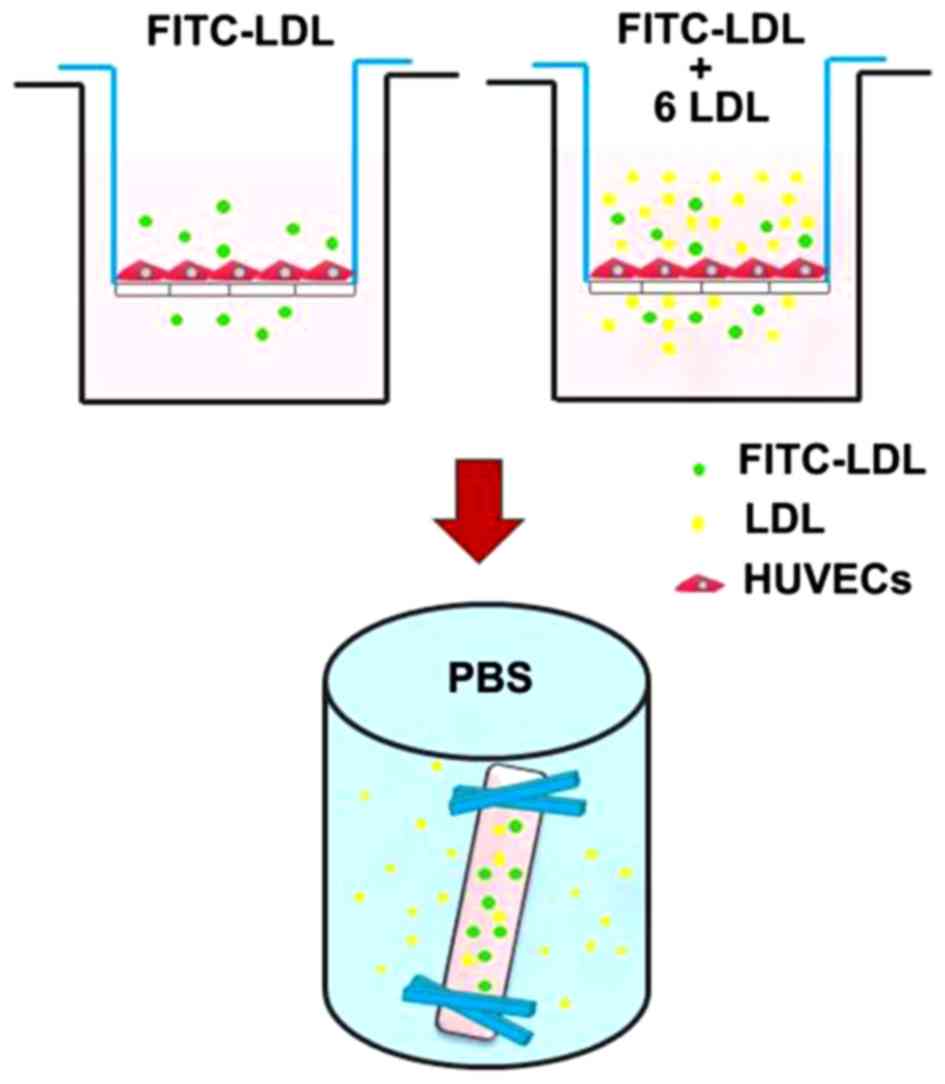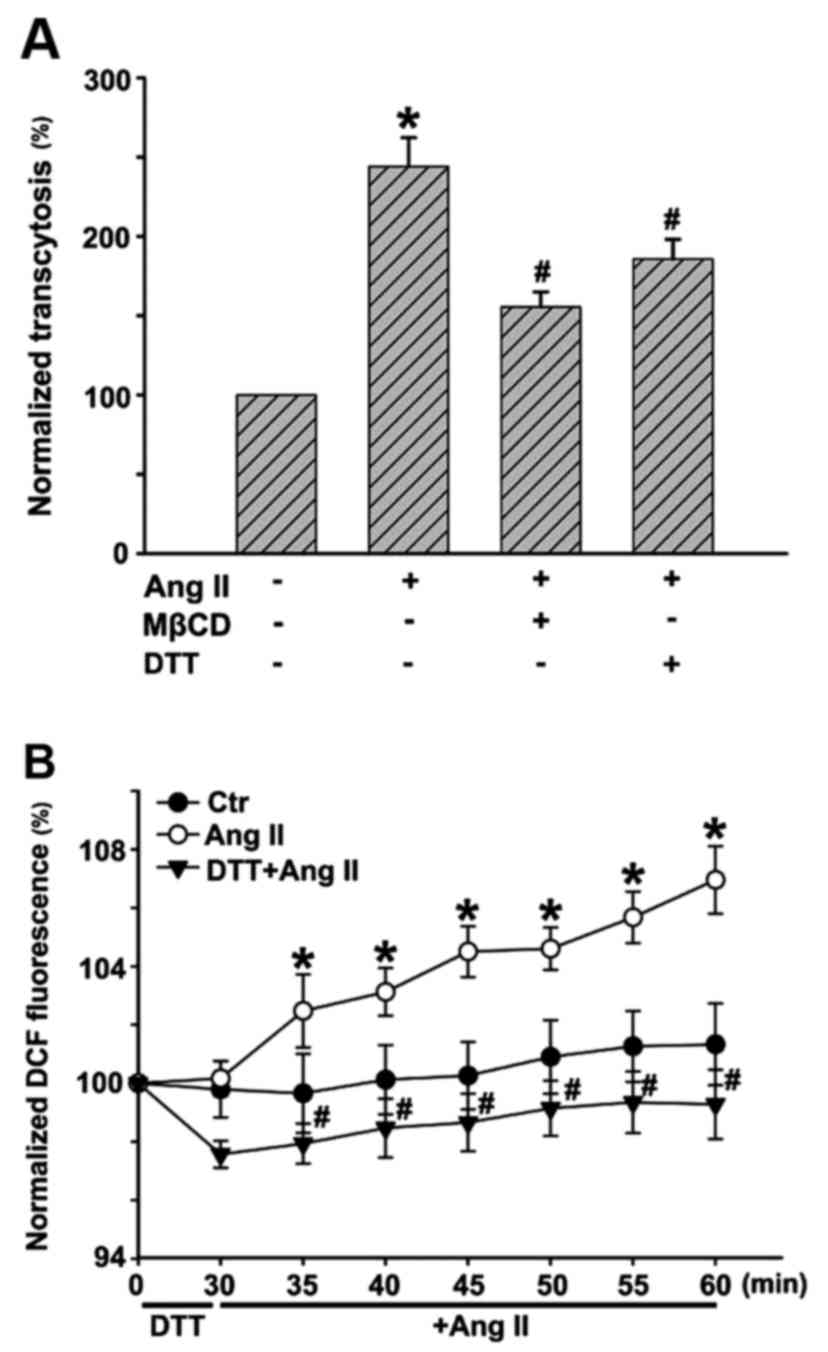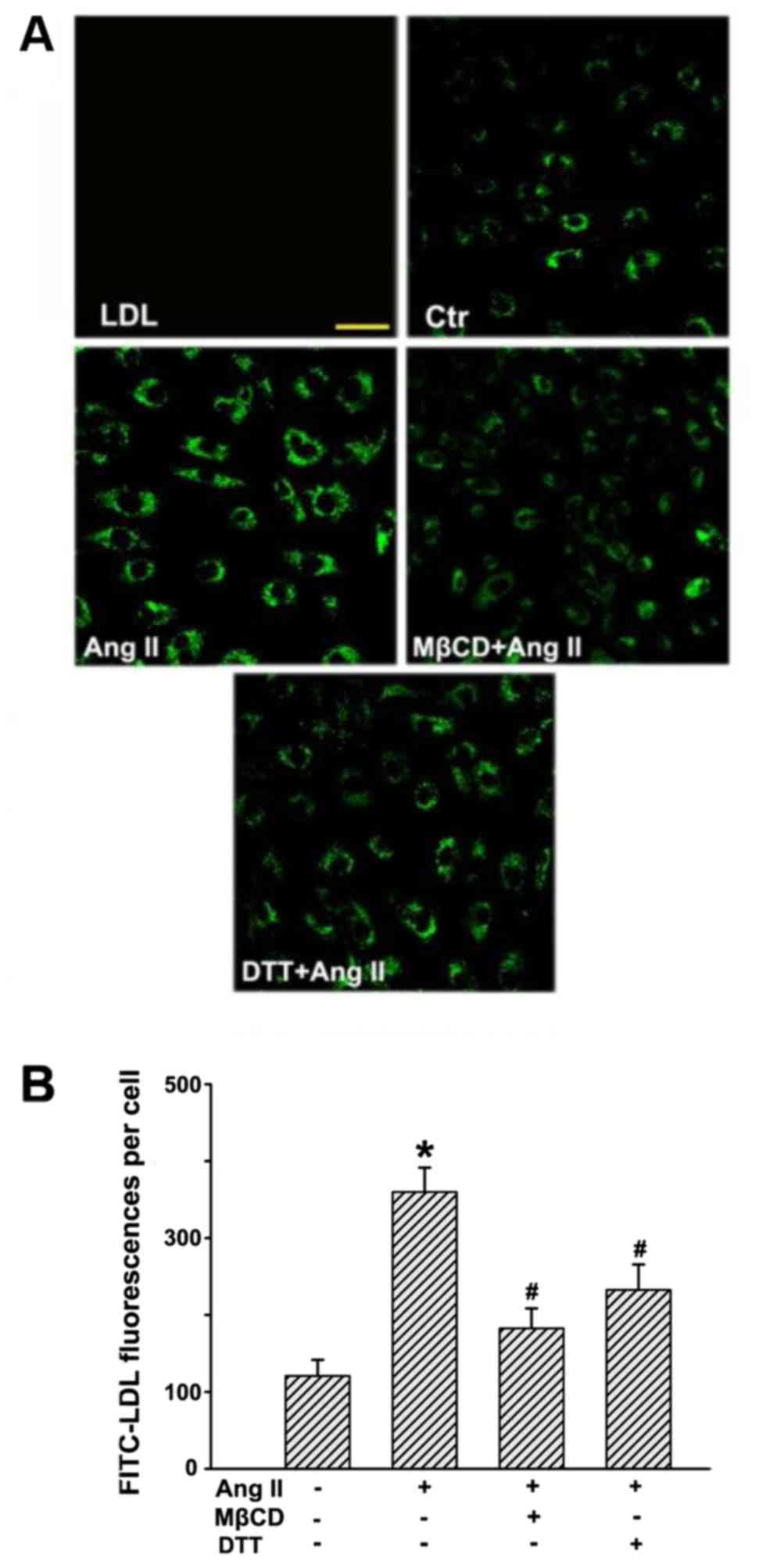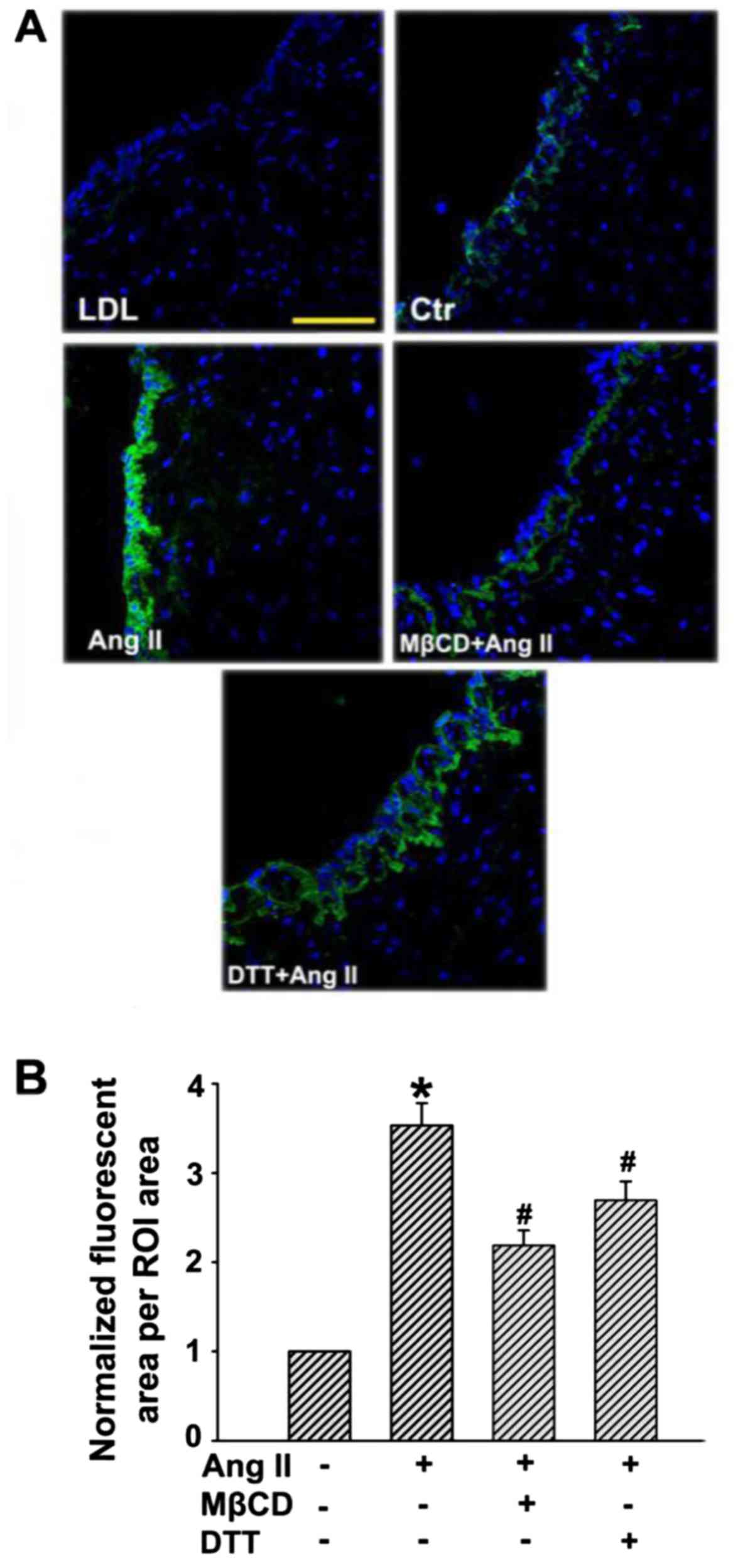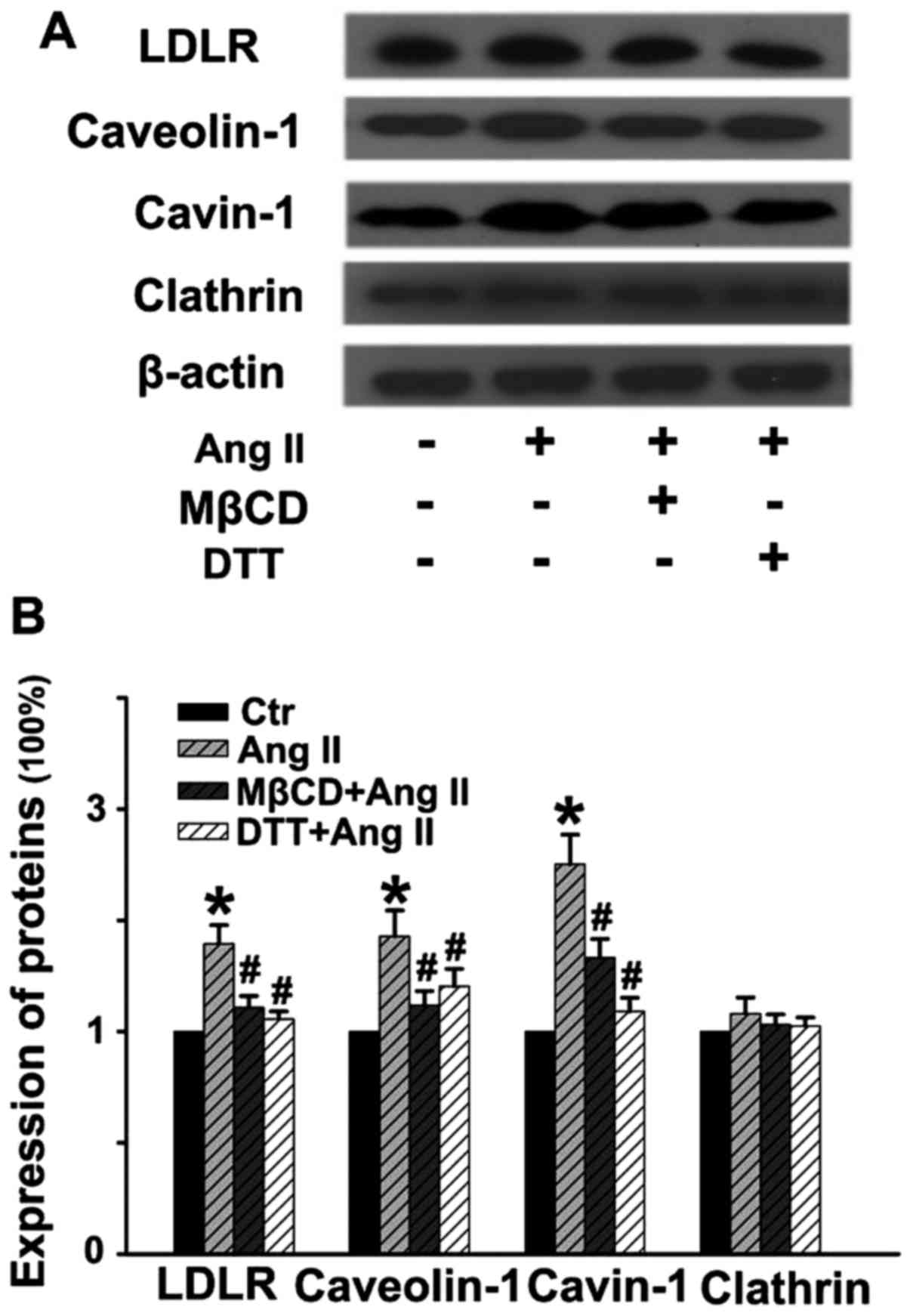|
1
|
Libby P, Ridker PM and Hansson GK:
Progress and challenges in translating the biology of
atherosclerosis. Nature. 473:317–325. 2011. View Article : Google Scholar : PubMed/NCBI
|
|
2
|
Bian F, Yang X, Zhou F, Wu PH, Xing S, Xu
G, Li W, Chi J, Ouyang C, Zhang Y, et al: C-reactive protein
promotes atherosclerosis by increasing LDL transcytosis across
endothelial cells. Br J Pharmacol. 171:2671–2684. 2014. View Article : Google Scholar : PubMed/NCBI
|
|
3
|
Zhang Y, Yang X, Bian F, Wu P, Xing S, Xu
G, Li W, Chi J, Ouyang C, Zheng T, et al: TNF-α promotes early
atherosclerosis by increasing transcytosis of LDL across
endothelial cells: crosstalk between NF-κB and PPAR-γ. J Mol Cell
Cardiol. 72:85–94. 2014. View Article : Google Scholar : PubMed/NCBI
|
|
4
|
Tabas I, Williams KJ and Borén J:
Subendothelial lipoprotein retention as the initiating process in
atherosclerosis: update and therapeutic implications. Circulation.
116:1832–1844. 2007. View Article : Google Scholar : PubMed/NCBI
|
|
5
|
Tuma P and Hubbard AL: Transcytosis:
crossing cellular barriers. Physiol Rev. 83:871–932. 2003.
View Article : Google Scholar : PubMed/NCBI
|
|
6
|
Bian F, Xiong B, Yang X and Jin S: Lipid
rafts, ceramide and molecular transcytosis. Front Biosci (Landmark
Ed). 21:806–838. 2016. View
Article : Google Scholar
|
|
7
|
Li W, Yang X, Xing S, Bian F, Yao W, Bai
X, Zheng T, Wu G and Jin S: Endogenous ceramide contributes to the
transcytosis of oxLDL across endothelial cells and promotes its
subendothelial retention in vascular wall. Oxid Med Cell Longev.
2014:8230712014. View Article : Google Scholar : PubMed/NCBI
|
|
8
|
McAlister FA; Renin Angiotension System
Modulator Meta-Analysis Investigators: Angiotensin-converting
enzyme inhibitors or angiotensin receptor blockers are beneficial
in normotensive atherosclerotic patients: a collaborative
meta-analysis of randomized trials. Eur Heart J. 33:505–514. 2012.
View Article : Google Scholar
|
|
9
|
Ohishi M, Dusting GJ, Fennessy PA,
Mendelsohn FA, Li XC and Zhuo JL: Increased expression and
co-localization of ACE, angiotensin II AT(1) receptors and
inducible nitric oxide synthase in atherosclerotic human coronary
arteries. Int J Physiol Pathophysiol Pharmacol. 2:111–124.
2010.PubMed/NCBI
|
|
10
|
Schieffer B, Schieffer E, Hilfiker-Kleiner
D, Hilfiker A, Kovanen PT, Kaartinen M, Nussberger J, Harringer W
and Drexler H: Expression of angiotensin II and interleukin 6 in
human coronary atherosclerotic plaques: potential implications for
inflammation and plaque instability. Circulation. 101:1372–1378.
2000. View Article : Google Scholar : PubMed/NCBI
|
|
11
|
Daugherty A, Manning MW and Cassis LA:
Angiotensin II promotes atherosclerotic lesions and aneurysms in
apolipo-protein E-deficient mice. J Clin Invest. 105:1605–1612.
2000. View
Article : Google Scholar : PubMed/NCBI
|
|
12
|
Weiss D, Kools JJ and Taylor WR:
Angiotensin II-induced hypertension accelerates the development of
atherosclerosis in apoE-deficient mice. Circulation. 103:448–454.
2001. View Article : Google Scholar : PubMed/NCBI
|
|
13
|
Griendling KK, Minieri CA, Ollerenshaw JD
and Alexander RW: Angiotensin II stimulates NADH and NADPH oxidase
activity in cultured vascular smooth muscle cells. Circ Res.
74:1141–1148. 1994. View Article : Google Scholar : PubMed/NCBI
|
|
14
|
Osterud B and Bjorklid E: Role of
monocytes in atherogenesis. Physiol Rev. 83:1069–1112. 2003.
View Article : Google Scholar : PubMed/NCBI
|
|
15
|
Pacurari M, Kafoury R, Tchounwou PB and
Ndebele K: The Renin-Angiotensin-aldosterone system in vascular
inflammation and remodeling. Int J Inflamm. 2014:6893602014.
View Article : Google Scholar
|
|
16
|
Ni W, Kitamoto S, Ishibashi M, Usui M,
Inoue S, Hiasa K, Zhao Q, Nishida K, Takeshita A and Egashira K:
Monocyte chemoattractant protein-1 is an essential inflammatory
mediator in angiotensin II-induced progression of established
atherosclerosis in hypercholesterolemic mice. Arterioscler Thromb
Vasc Biol. 24:534–539. 2004. View Article : Google Scholar : PubMed/NCBI
|
|
17
|
Li XC and Zhuo JL: Nuclear factor-kappaB
as a hormonal intracellular signaling molecule: focus on
angiotensin II-induced cardiovascular and renal injury. Curr Opin
Nephrol Hypertens. 17:37–43. 2008. View Article : Google Scholar
|
|
18
|
Li W, Li Z, Chen Y, Li S, Lv Y, Zhou W,
Liao M, Zhu F, Zhou Z, Cheng X, et al: Autoantibodies targeting
AT1 receptor from patients with acute coronary syndrome
upregulate proinflammatory cytokines expression in endothelial
cells involving NF-κB pathway. J Immunol Res. 2014:3426932014.
|
|
19
|
Rius C, Abu-Taha M, Hermenegildo C,
Piqueras L, Cerda-Nicolas JM, Issekutz AC, Estañ L, Cortijo J,
Morcillo EJ, Orallo F, et al: Trans- but not cis-resveratrol
impairs angiotensin-II-mediated vascular inflammation through
inhibition of NF-κB activation and peroxisome
proliferator-activated receptor-gamma upregulation. J Immunol.
185:3718–3727. 2010. View Article : Google Scholar : PubMed/NCBI
|
|
20
|
Rajagopalan S, Kurz S, Münzel T, Tarpey M,
Freeman BA, Griendling KK and Harrison DG: Angiotensin II-mediated
hypertension in the rat increases vascular superoxide production
via membrane NADH/NADPH oxidase activation. Contribution to
alterations of vasomotor tone. J Clin Invest. 97:1916–1923. 1996.
View Article : Google Scholar : PubMed/NCBI
|
|
21
|
Eto H, Miyata M, Shirasawa T, Akasaki Y,
Hamada N, Nagaki A, Orihara K, Biro S and Tei C: The long-term
effect of angiotensin II type 1a receptor deficiency on
hypercholesterolemia-induced atherosclerosis. Hypertens Res.
31:1631–1642. 2008. View Article : Google Scholar : PubMed/NCBI
|
|
22
|
Daugherty A, Rateri DL, Lu H, Inagami T
and Cassis LA: Hypercholesterolemia stimulates angiotensin peptide
synthesis and contributes to atherosclerosis through the AT1A
receptor. Circulation. 110:3849–3857. 2004. View Article : Google Scholar : PubMed/NCBI
|
|
23
|
Kunieda T, Minamino T, Nishi J, Tateno K,
Oyama T, Katsuno T, Miyauchi H, Orimo M, Okada S, Takamura M, et
al: Angiotensin II induces premature senescence of vascular smooth
muscle cells and accelerates the development of atherosclerosis via
a 21-dependent pathway. Circulation. 114:953–960. 2006. View Article : Google Scholar : PubMed/NCBI
|
|
24
|
Wang S, Subramanian V, Lu H, Howatt DA,
Moorleghen JJ, Charnigo R, Cassis LA and Daugherty A: Deficiency of
receptor-associated protein attenuates angiotensin II-induced
atherosclerosis in hypercholesterolemic mice without influencing
abdominal aortic aneurysms. Atherosclerosis. 220:375–380. 2012.
View Article : Google Scholar :
|
|
25
|
Wu SJ, Soulez M, Yang YH, Chu CS, Shih SC,
Hébert MJ, Kuo MC and Hsieh YJ: Local augmented angiotensinogen
secreted from apoptotic vascular endothelial cells is a vital
mediator of vascular remodelling. PLoS One. 10:e01325832015.
View Article : Google Scholar : PubMed/NCBI
|
|
26
|
Libby P: Inflammation in atherosclerosis.
Arterioscler Thromb Vasc Biol. 32:2045–2051. 2012. View Article : Google Scholar : PubMed/NCBI
|
|
27
|
Schupp N, Kolkhof P, Queisser N, Gärtner
S, Schmid U, Kretschmer A, Hartmann E, Oli RG, Schäfer S and
Stopper H: Mineralocorticoid receptor-mediated DNA damage in
kidneys of DOCA-salt hypertensive rats. FASEB J. 25:968–978. 2011.
View Article : Google Scholar
|
|
28
|
Calhoun DA, White WB, Krum H, Guo W,
Bermann G, Trapani A, Lefkowitz MP and Ménard J: Effects of a novel
aldosterone synthase inhibitor for treatment of primary
hypertension: results of a randomized, double-blind, placebo- and
active-controlled phase 2 trial. Circulation. 124:1945–1955. 2011.
View Article : Google Scholar : PubMed/NCBI
|
|
29
|
Takata H, Yamada H, Kawahito H, Kishida S,
Irie D, Kato T, Wakana N, Miyagawa S, Fukui K and Matsubara H:
Vascular angiotensin II type 2 receptor attenuates atherosclerosis
via a kinin/NO-dependent mechanism. J Renin Angiotensin Aldosterone
Syst. 16:311–320. 2015. View Article : Google Scholar
|
|
30
|
Catar RA, Müller G, Heidler J, Schmitz G,
Bornstein SR and Morawietz H: Low-density lipoproteins induce the
renin-angiotensin system and their receptors in human endothelial
cells. Horm Metab Res. 39:801–805. 2007. View Article : Google Scholar : PubMed/NCBI
|
|
31
|
Wang X, Phillips MI and Mehta JL: LOX-1
and angiotensin receptors, and their interplay. Cardiovasc Drugs
Ther. 25:401–417. 2011. View Article : Google Scholar : PubMed/NCBI
|
|
32
|
Sendra J, Llorente-Cortés V, Costales P,
Huesca-Gómez C and Badimon L: Angiotensin II upregulates LDL
receptor-related protein (LRP1) expression in the vascular wall: a
new pro-atherogenic mechanism of hypertension. Cardiovasc Res.
78:581–589. 2008. View Article : Google Scholar : PubMed/NCBI
|
|
33
|
Cardona-Sanclemente LE, Medina R and Born
GV: Effect of increasing doses of angiotensin II infused into
normal and hypertensive Wistar rats on low density lipoprotein and
fibrinogen uptake by aortic walls. Proc Natl Acad Sci USA.
91:3285–3288. 1994. View Article : Google Scholar : PubMed/NCBI
|
|
34
|
Keidar S, Heinrich R, Kaplan M, Hayek T
and Aviram M: Angiotensin II administration to atherosclerotic mice
increases macrophage uptake of oxidized ldl: a possible role for
interleukin-6. Arterioscler Thromb Vasc Biol. 21:1464–1469. 2001.
View Article : Google Scholar : PubMed/NCBI
|
|
35
|
Frank PG, Pavlides S and Lisanti MP:
Caveolae and transcytosis in endothelial cells: role in
atherosclerosis. Cell Tissue Res. 335:41–47. 2009. View Article : Google Scholar
|
|
36
|
Kirchhausen T, Owen D and Harrison SC:
Molecular structure, function, and dynamics of clathrin-mediated
membrane traffic. Cold Spring Harb Perspect Biol. 6:a0167252014.
View Article : Google Scholar : PubMed/NCBI
|
|
37
|
El-Sayed A and Harashima H: Endocytosis of
gene delivery vectors: from clathrin-dependent to lipid
raft-mediated endocytosis. Mol Ther. 21:1118–1130. 2013. View Article : Google Scholar : PubMed/NCBI
|
|
38
|
Sorrentino V, Nelson JK, Maspero E,
Marques AR, Scheer L, Polo S and Zelcer N: The LXR-IDOL axis
defines a clathrin-, caveolae-, and dynamin-independent endocytic
route for LDLR internalization and lysosomal degradation. J Lipid
Res. 54:2174–2184. 2013. View Article : Google Scholar : PubMed/NCBI
|
|
39
|
Howes MT, Mayor S and Parton RG:
Molecules, mechanisms, and cellular roles of clathrin-independent
endocytosis. Curr Opin Cell Biol. 22:519–527. 2010. View Article : Google Scholar : PubMed/NCBI
|
|
40
|
Simionescu M, Popov D and Sima A:
Endothelial transcytosis in health and disease. Cell Tissue Res.
335:27–40. 2009. View Article : Google Scholar
|
|
41
|
Pavlides S, Gutierrez-Pajares JL,
Iturrieta J, Lisanti MP and Frank PG: Endothelial caveolin-1 plays
a major role in the development of atherosclerosis. Cell Tissue
Res. 356:147–157. 2014. View Article : Google Scholar : PubMed/NCBI
|
|
42
|
Predescu SA, Predescu DN and Malik AB:
Molecular determinants of endothelial transcytosis and their role
in endothelial permeability. Am J Physiol Lung Cell Mol Physiol.
293:L823–L842. 2007. View Article : Google Scholar : PubMed/NCBI
|
|
43
|
Nassar ZD, Hill MM, Parton RG and Parat
MO: Caveola-forming proteins caveolin-1 and PTRF in prostate
cancer. Nat Rev Urol. 10:529–536. 2013.PubMed/NCBI
|
|
44
|
Regazzetti C, Dumas K, Lacas-Gervais S,
Pastor F, Peraldi P, Bonnafous S, Dugail I, Le Lay S, Valet P, Le
Marchand-Brustel Y, et al: Hypoxia inhibits cavin-1 and cavin-2
expression and down-regulates caveolae in adipocytes.
Endocrinology. 156:789–801. 2015. View Article : Google Scholar
|















